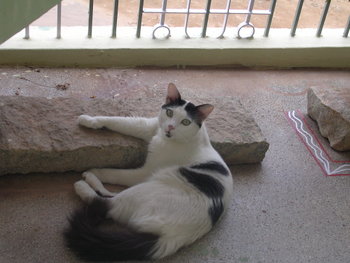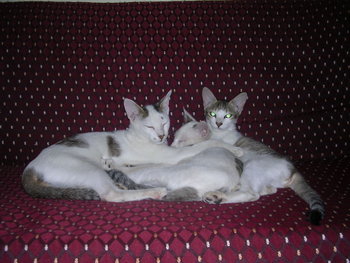
 Happy Cat
Happy Cat
Cats, like many other animals, communicate a variety of messages using body language. Examples include arching their backs as a signal of fear or aggression and slowly blinking to signal relaxation. As is the case with dogs, the tail is often used as a signalling mechanism. A twitch can indicate minor irritation, and a tail held high suggests confidence. A cat who chooses to lie with its stomach and chest exposed conveys happiness, trust and comfort. A cat with tail held high and twitching shows excitement, but this is often mistaken for anger. Flattened ears mean that the cat feels threatened, and may attack. Mouth open and no teeth exposed suggests a feeling of playfulness.
Many people fail to understand the silent language of cats. In particular, 'dog people who are accustomed to the fawning outwards signs of dog 'language' seem slow in detecting what a cat is telling them in its body language, which creates the false impression among dog people that cats are cold-hearted, unemotional, or dumb. To understand cats, one must observe a feline closely and learn what its body signals tell you. The flattened ears, teeth showing, baring belly for submission are easily 'read' by humans. Some characteristic signals, however, are often misunderstood. For instance, a cat rubbing its body along an arm or leg of its human is not only a way in which to attract attention and, perhaps, a morsel of food. It is also a way of 'marking' its human as its very own. Using scent glands located around its mouth and elswhere, it subtly 'marks' its human as part of its cat territory. Most cats prefer gentle rubs behind the ears. To inform their humans they need petting or attention, a cat may push its entire body weight up against the human as the cat snuggles next to his/her favorite person.
Some subtle Anthropomorphisms
- Disgust - Lifting and subsequent shaking of a paw or paws is sign of disgust. The more paws the more disgusting. This can sometimes be a four paw affair with each paw being lifted and shaken before the other.
- Agitation - The swishing or sweeping of the tail in one full 180 degree swoop mid-air or against the human. And if the message isn't getting through, the cat may simply leave the room.
External links
- A small catalogue of cat body language signals.
- An introduction to cat body language
- Cat Communication
Cats body language, communicate, messages, body language, arching their backs, signal, fear, aggression, slowly blinking, signal relaxation

